Effect of Lower-Level Relaxation on the Pulse Generation Performance of Q-Switched Nd:YAG Laser
Abstract
:1. Introduction
2. Theoretical Principles
2.1. Theoretical Analysis and Simulation Model Design
- (1).
- Theoretical Model
- (2).
- Simulation Model and Parametric Design
- (3)
- Key Factors Involved in Simulations
- (a).
- Spatial Distribution of Pump Light
- (b).
- Thermal Effects and Equivalent Thermal Lensing
- (c).
- Intracavity Light Field
- (d).
- Lower-Level Relaxation Time
2.2. Simulation Algorithm
3. Simulation Results and Experimental Validation
4. Conclusions
5. Discussion
Author Contributions
Funding
Institutional Review Board Statement
Informed Consent Statement
Data Availability Statement
Acknowledgments
Conflicts of Interest
References
- Su, W.; Zhong, J.; Zhang, L.; Cen, X.; Li, L.; Zhao, Y. Numerical Simulation Study on Field of Temperature During the Growth of Nd:YAG Crystal. Chin. J. Lasers 2003, 30, 334. [Google Scholar]
- Yao, G.; Zhang, L.; Li, J.; Gu, Y.; Bai, R. Study on application of doped colour center Nd: YAG crystals. Chin. J. Lasers 1990, 17, 141. [Google Scholar]
- Zhou, J.; Qiao, J.; Deng, P. Investigation of damage and dislocation structure in LiF crystals by 1.06μm Nd:YAG pulsed laser radiation. Chin. J. Lasers 1989, 16, 432. [Google Scholar]
- Jiang, B.; Xu, J.; Li, J. Temperature Gradient Technique Grown Nd:YAG Crystal for Heat Capacity Laser with Laser Output of 1200 W. Chin. J. Lasers 2006, 33, 973. [Google Scholar]
- Su, W.; Zhong, J.; Zhang, L.; Cen, X.; Li, L.; Zhao, Y. Numerical Simulation Study on Field of NdNd3+ Concentration during the Growth of Nd: YAG Crystal. Chin. J. Lasers 2003, 30, 435. [Google Scholar]
- Cheng, H.; Ma, X.; Liu, R.; Xu, X.; Gui, Y. Growth study of φ80 mm Nd:YAG Crystals by Czochralski Method. Chin. J. Lasers 2004, 31, 510. [Google Scholar]
- Sun, X.; Yu, Y.; Pei, B. High Power Diode-Pumped Nd:YAG 1.319 μm TEM00 Laser. Chin. J. Lasers 2004, 31, 55. [Google Scholar]
- Jiang, D.; Zhao, H.; Wang, J.; Zhou, S. LD Pumped Nd:YAG Laser with Output Power of 300 W. Chin. J. Lasers 2004, 31, 8. [Google Scholar]
- Li, R.; Yu, J.; Lai, Y.; Ma, X. LD Pumped Nd: YAG/LBO Blue Laser. Chin. J. Lasers 2002, 29, 105. [Google Scholar]
- Zhou, S.; Jiang, D.; Zhao, H.; Wang, J.; Zhao, H. LD Pumped Hectowatt Nd: YAG Laser. Chin. J. Lasers 2002, 29, 119. [Google Scholar]
- Ning, J.; Ni, W.; Yang, T.; Zhan, Y.; Lu, X.; Yao, J. Study of Diode-pumped Multi-wavelength Nd:YAG Laser. Chin. J. Lasers 2002, 29, 123. [Google Scholar]
- Wang, J.; Zhang, W. Investigation on Nd:YAG/KTP/Cr4+ YAG Picosecond Green Laser. Chin. J. Lasers 2002, 29, 56. [Google Scholar]
- Siegman, A.E. Lasers; University Sciences Books: Mill Valley, CA, USA, 1986; Chapter 26. [Google Scholar]
- Bartschke, J.; Boller, K.J.; Wallenstein, R.; Klimov, I.V.; Tsvetkov, V.B.; Shcherbakov, I.A. Diode-pumped passively Q-switched self-frequency-doubling Nd:YAB laser. J. Opt. Soc. Am. B 1997, 14, 3452–3456. [Google Scholar] [CrossRef]
- Ng, S.P.; Tang, D.Y.; Qian, L.J.; Qin, L.J. Satellite Pulse Generation in Diode-Pumped Passively Q-Switched Nd:GdVO4 Lasers. IEEE J. Quantum Electron. 2006, 42, 625–632. [Google Scholar] [CrossRef]
- Li, S.; Huang, W. Principles and Design of Laser Devices; National Defense Industry Press: Beijing, China, 1998. [Google Scholar]
- Zhou, B. Laser Principle; National Defense Industry Press: Beijing, China, 2007; Volume 11, pp. 145–149. [Google Scholar]
- Qu, P. Research on Key Technologies of Compact High-Energy Solid-State Laser. Ph.D. Thesis, Xi’an University of Electronic Science and Technology, Xi’an, China, 2017. [Google Scholar]
- Li, Q.; Wang, Z.; Wang, Z.; Fang, M. Thermal Lens Focal Length Measurement of High Power Lamp Pumped CW Nd:YAG Laser. Chin. J. Lasers 2004, 31, 1117. [Google Scholar]
- Chang, R.; Shi, P.; Zhang, Y.; Xin, Y.; Bai, B. Influence of Air Heat Transfer Coefficient on Thermal Distortion Analysis of Nd:YAG Microchip Laser. Chin. J. Lasers 2010, 37, 1708. [Google Scholar] [CrossRef]
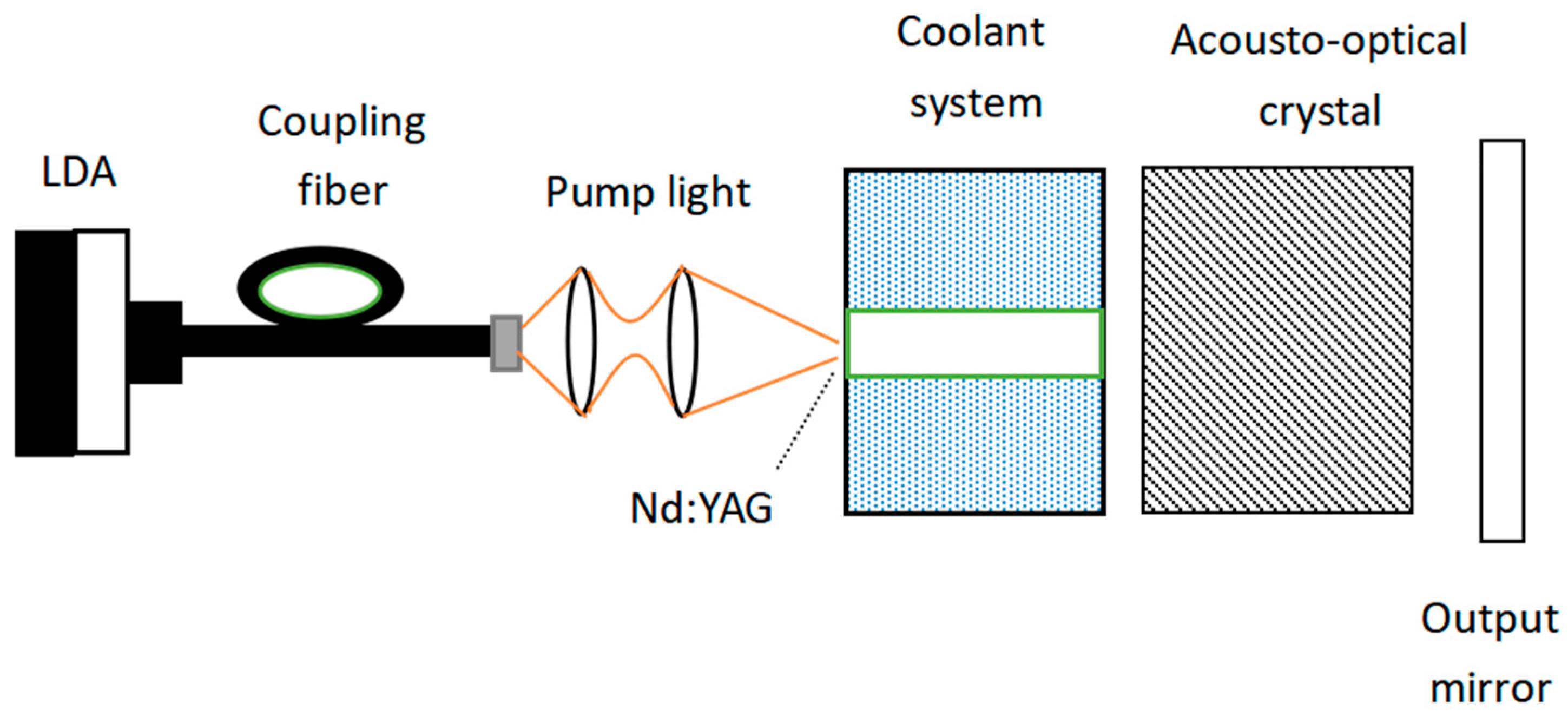
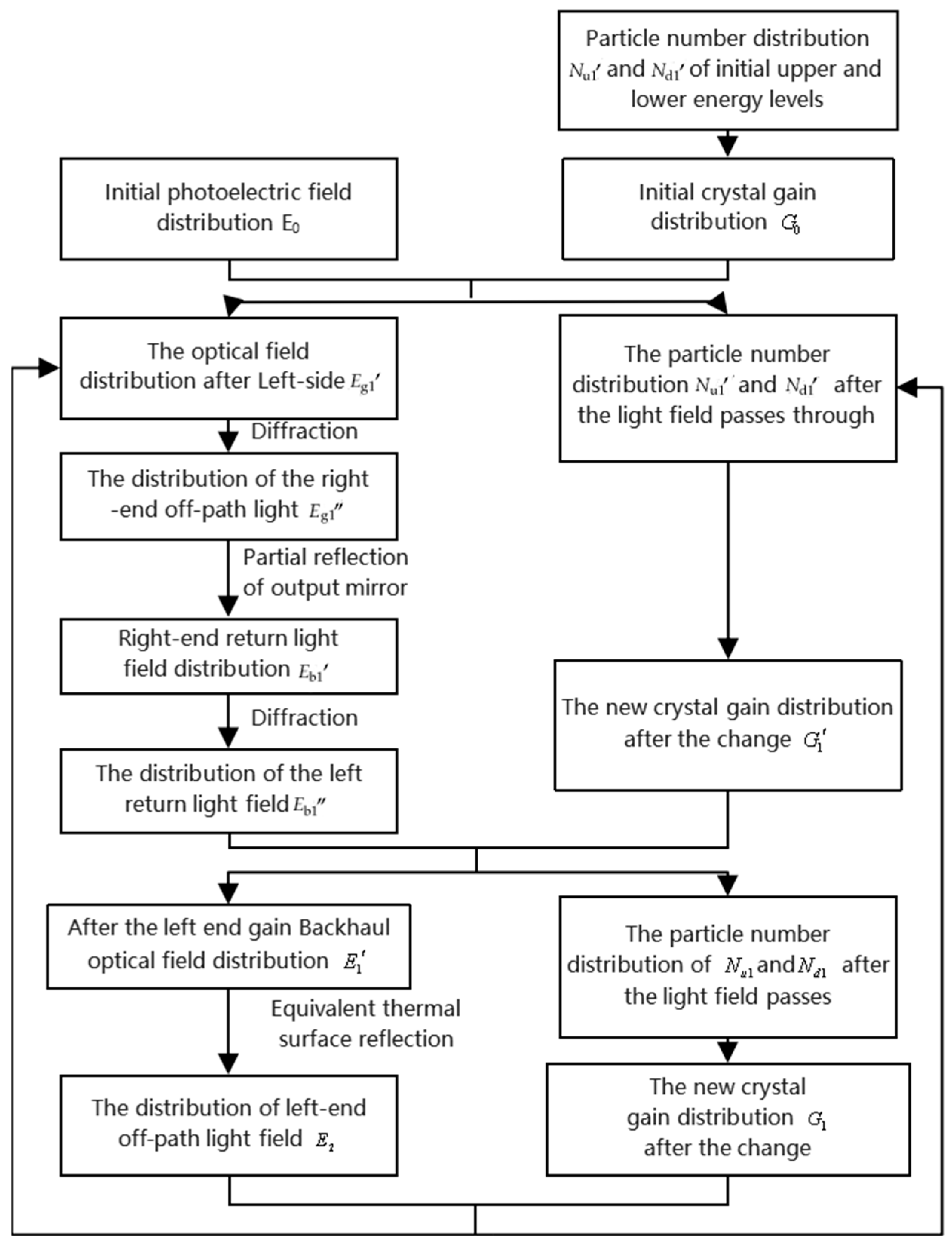
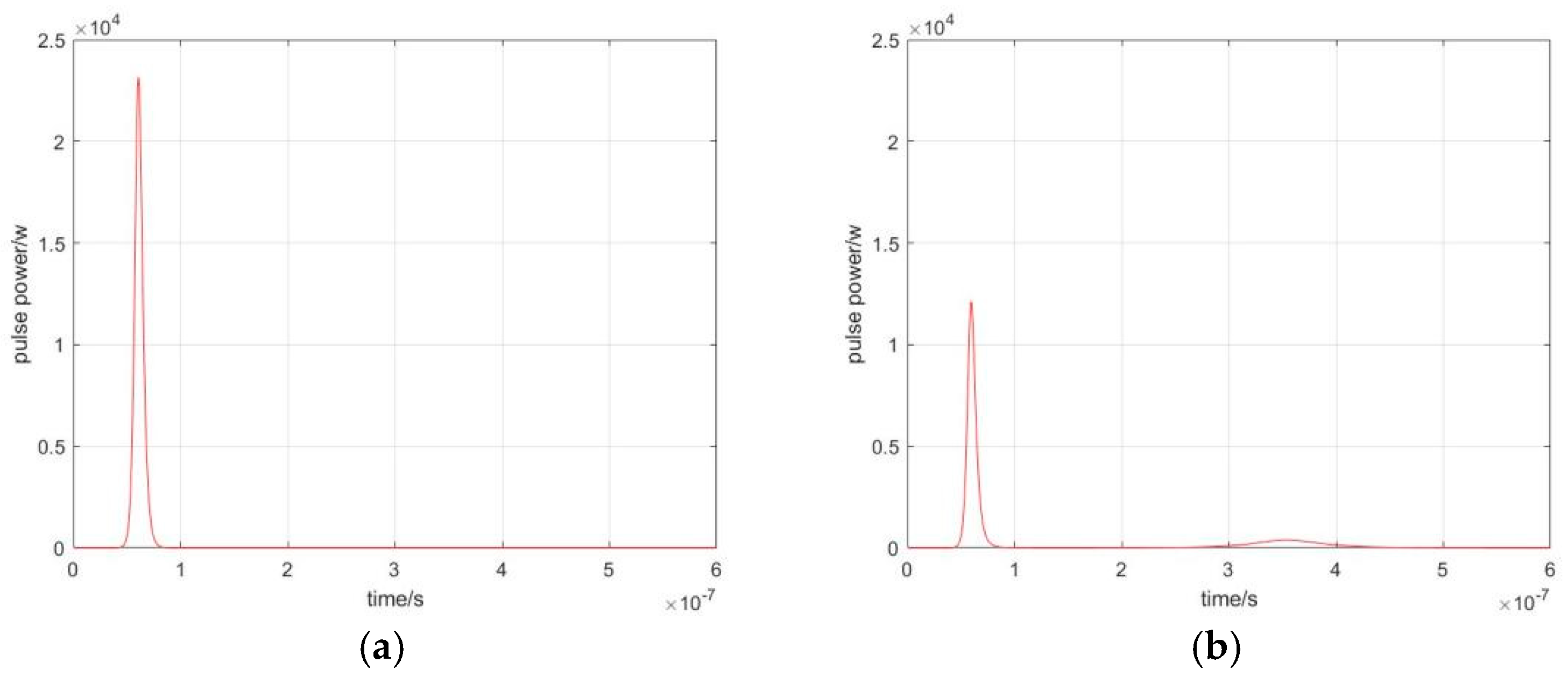
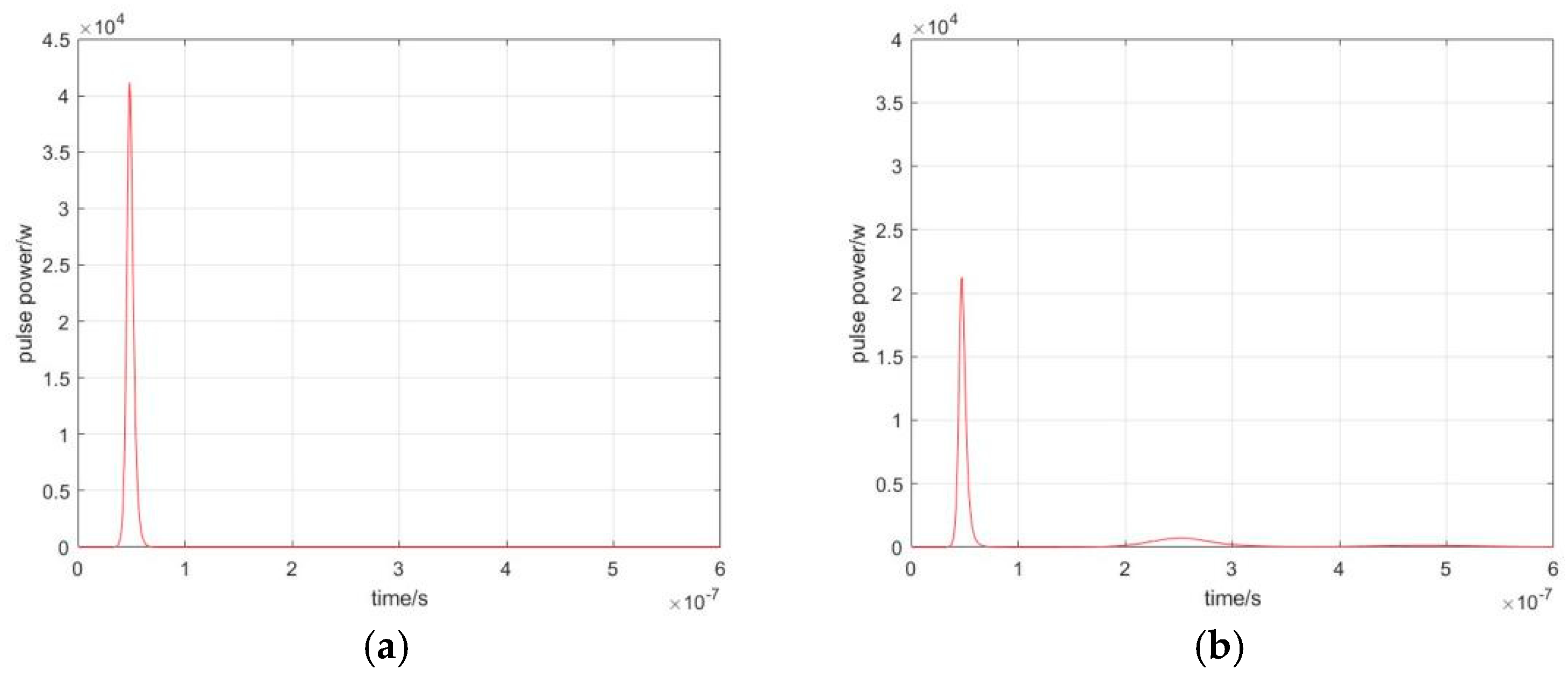



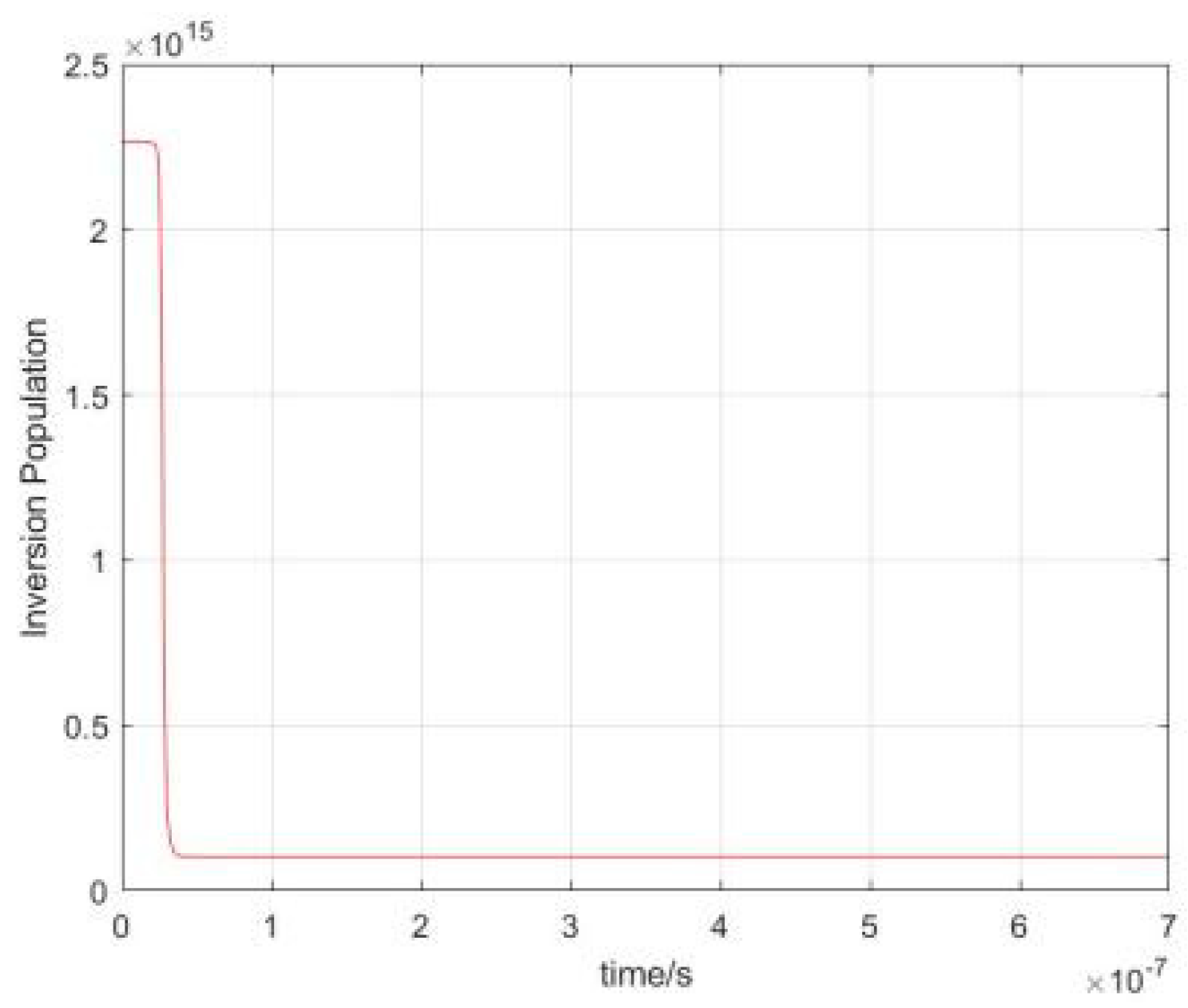

| NLELA | LELA | Peak Power Ratio | Pulse Energy Ratio | |||||
|---|---|---|---|---|---|---|---|---|
| Pump Power (W) | Peak Pulse Power (kW) | Pulse Width (ns) | Pulse Energy (μJ) | Peak Pulse Power (kW) | Pulse Width (ns) | Pulse Energy (μJ) | ||
| 80 | 23 | 8 | 184 | 12 | 8.8 | 105.6 | 1.92 | 1.74 |
| 90 | 41 | 6.6 | 270.6 | 21 | 6.6 | 138.6 | 1.95 | 1.95 |
| 100 | 66 | 6.5 | 429 | 34 | 5.9 | 200.6 | 1.94 | 2.14 |
| Main Pulse | Sub-Pulse | Peak Power Ratio | Pulse Energy Ratio | |||||
|---|---|---|---|---|---|---|---|---|
| Pump Power (W) | Peak Pulse Power (kW) | Pulse Width (ns) | Pulse Energy (μJ) | Peak Pulse Power (kW) | Pulse Width (ns) | Pulse Energy (μJ) | ||
| 80 | 12 | 8.8 | 105.6 | 0.383 | 72 | 27.58 | 31.33 | 3.83 |
| 90 | 21 | 6.6 | 138.6 | 0.703 | 68 | 47.80 | 29.87 | 2.90 |
| 100 | 34 | 5.9 | 200.6 | 0.904 | 44 | 39.78 | 37.61 | 5.04 |
Disclaimer/Publisher’s Note: The statements, opinions and data contained in all publications are solely those of the individual author(s) and contributor(s) and not of MDPI and/or the editor(s). MDPI and/or the editor(s) disclaim responsibility for any injury to people or property resulting from any ideas, methods, instructions or products referred to in the content. |
© 2025 by the authors. Licensee MDPI, Basel, Switzerland. This article is an open access article distributed under the terms and conditions of the Creative Commons Attribution (CC BY) license (https://creativecommons.org/licenses/by/4.0/).
Share and Cite
Ma, F.; Wang, S.; Li, B.; Shang, P.; Li, J.; Li, Z. Effect of Lower-Level Relaxation on the Pulse Generation Performance of Q-Switched Nd:YAG Laser. Photonics 2025, 12, 408. https://doi.org/10.3390/photonics12050408
Ma F, Wang S, Li B, Shang P, Li J, Li Z. Effect of Lower-Level Relaxation on the Pulse Generation Performance of Q-Switched Nd:YAG Laser. Photonics. 2025; 12(5):408. https://doi.org/10.3390/photonics12050408
Chicago/Turabian StyleMa, Fuqiang, Shiyu Wang, Bingbin Li, Peijin Shang, Jinyou Li, and Zheyuan Li. 2025. "Effect of Lower-Level Relaxation on the Pulse Generation Performance of Q-Switched Nd:YAG Laser" Photonics 12, no. 5: 408. https://doi.org/10.3390/photonics12050408
APA StyleMa, F., Wang, S., Li, B., Shang, P., Li, J., & Li, Z. (2025). Effect of Lower-Level Relaxation on the Pulse Generation Performance of Q-Switched Nd:YAG Laser. Photonics, 12(5), 408. https://doi.org/10.3390/photonics12050408




